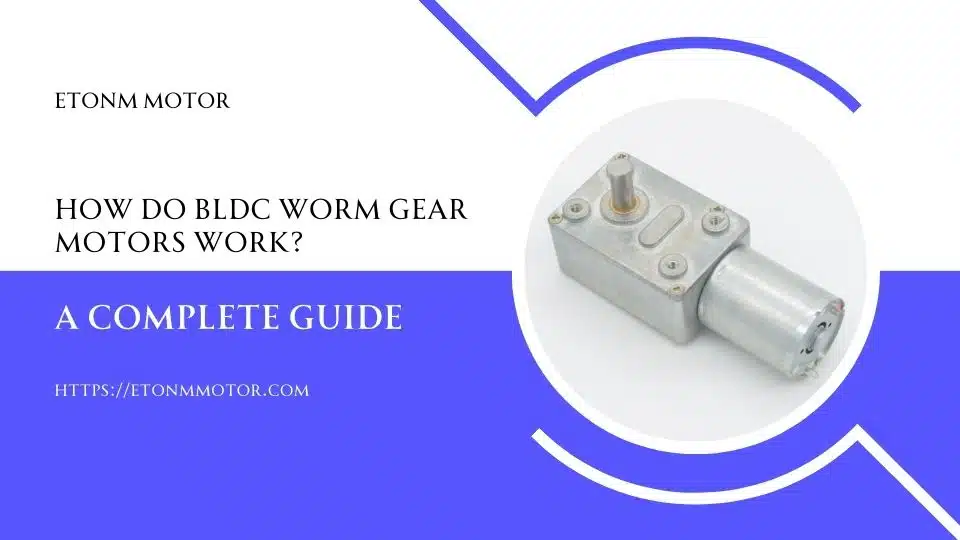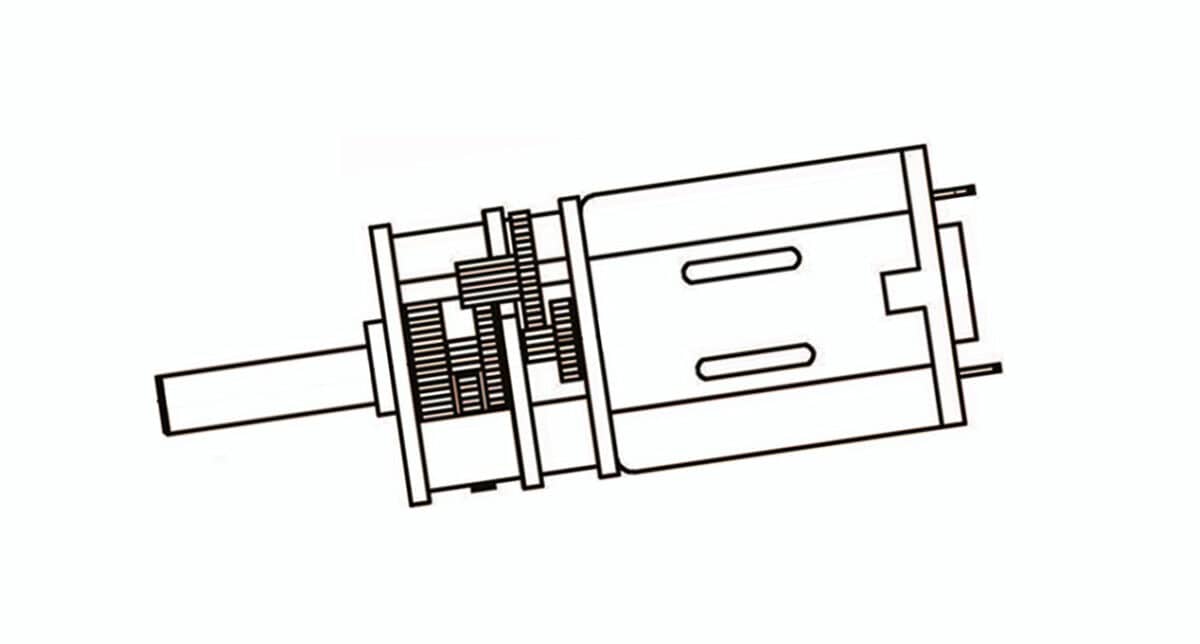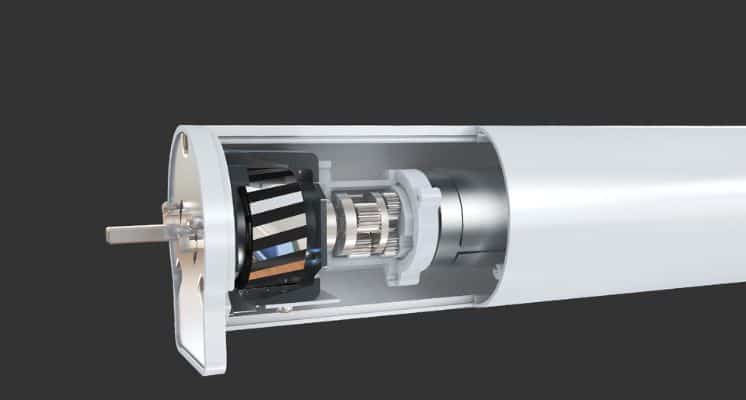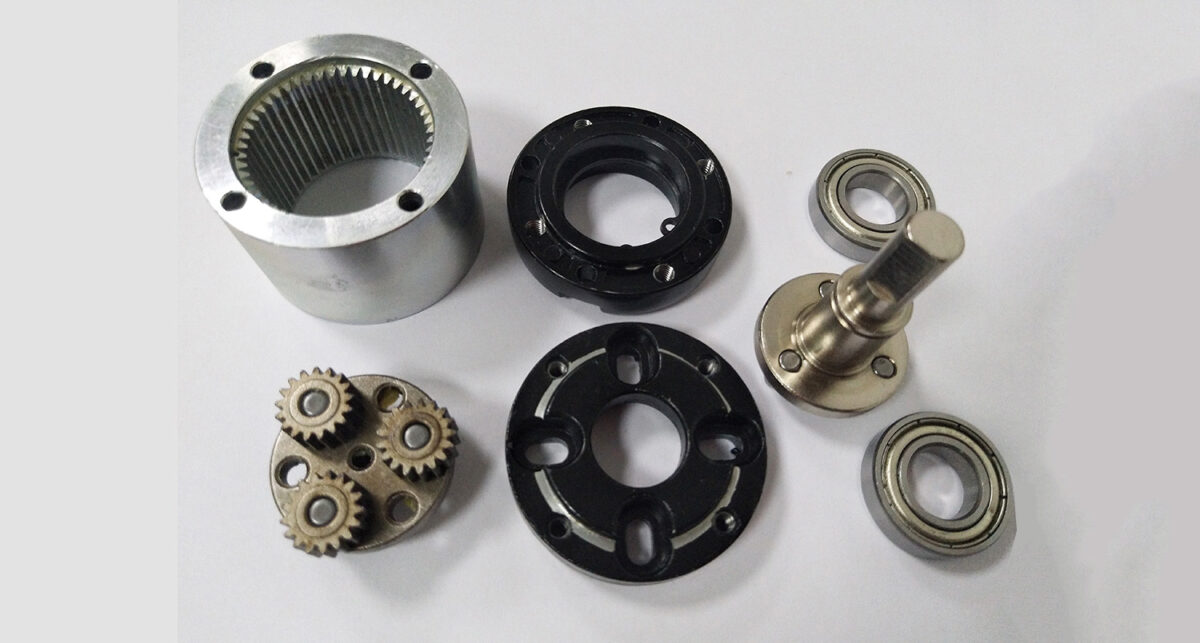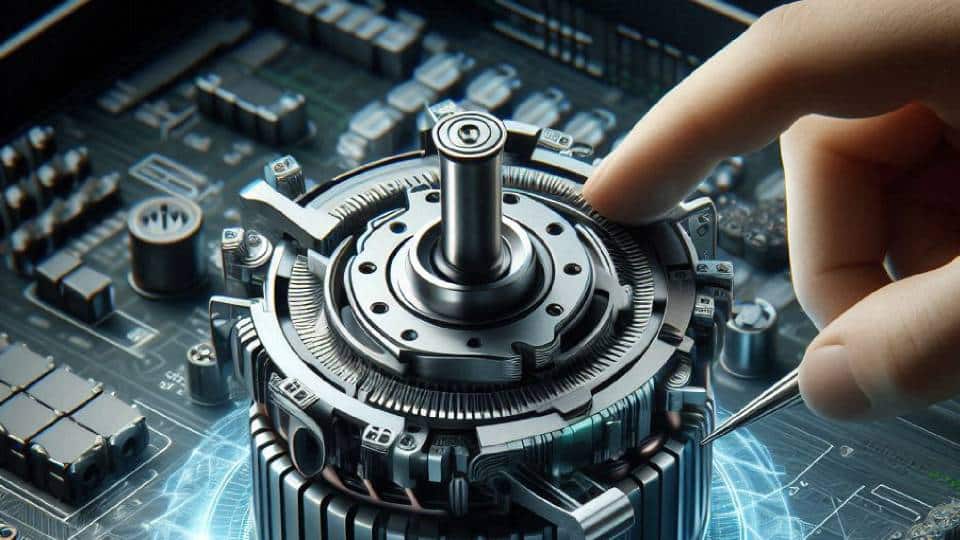Discover how BLDC worm gear motors combine brushless DC technology with worm gear mechanisms to deliver high torque, precision, and efficiency in compact designs. Perfect for robotics, automation, and more.
Table of Contents
Introduction
In the world of compact, high-performance motors, BLDC Worm Gear Motors has emerged as a game-changer. Combining the efficiency of brushless DC (BLDC) motors with the mechanical advantages of worm gears, these motors are revolutionizing industries like robotics, automation, and smart home systems. But how exactly do they work, and why are they so effective?
A BLDC Worm Gear Motor is essentially a fusion of two powerful technologies: a brushless DC motor, known for its high efficiency and long lifespan, and a worm gear mechanism, which provides exceptional torque and precise control. This combination makes them ideal for applications where space is limited, but performance cannot be compromised—think robotic arms, automated dispensers, or even electric valves in smart home systems.
In this guide, we’ll break down the working principles of BLDC Worm Gear Motors, explore their key components, and highlight why they’re the go-to choice for engineers and designers looking for reliable, high-torque solutions in compact packages. Whether you’re building a robot, designing a vending machine, or working on a medical device, understanding how these motors work can help you make the right choice for your application.
Stay tuned as we dive deeper into the world of brushless worm gear motors and uncover what makes them so versatile and powerful!
What is a BLDC Worm Gear Motor?
At its core, a BLDC Worm Gear Motor is a sophisticated combination of two key technologies: a brushless DC motor (BLDC) and a worm gear mechanism. This unique pairing brings together the best of both worlds—high efficiency, precise control, and compact design—making it a standout choice for a wide range of applications.
The Brushless DC Motor Component
The brushless DC motor is the heart of the system. Unlike traditional brushed motors, which rely on physical brushes for commutation, BLDC motors use electronic commutation. This means they are more efficient, produce less heat, and have a longer lifespan. The motor consists of two main parts:
- Stator: The stationary part that generates a magnetic field when electric current flows through its windings.
- Rotor: The rotating part that contains permanent magnets, which interact with the stator’s magnetic field to produce motion.
The Worm Gear Mechanism
The worm gear is the mechanical powerhouse of the system. It consists of two main components:
- Worm: A screw-like threaded shaft that connects to the motor’s output.
- Gear Wheel: A toothed wheel that meshes with the worm.
When the motor rotates, it drives the worm, which in turn moves the gear wheel. This interaction results in a significant reduction in speed but a substantial increase in torque. The worm gear’s design also offers another advantage: it’s inherently self-locking, meaning it can hold loads in place without additional braking mechanisms.
Why Combine BLDC Motors with Worm Gears?
The combination of a BLDC motor and a worm gear creates a motor system that is both powerful and precise. The BLDC motor provides the rotational power, while the worm gear translates that power into high torque and controlled motion. This makes BLDC Worm Gear Motors ideal for applications that require both strength and accuracy, such as robotic arms, automated systems, and medical devices.
How Does a Brushless DC Motor Work?
To fully understand how a BLDC Worm Gear Motor operates, it’s essential to first grasp the working principles of its core component: the brushless DC motor (BLDC). Unlike traditional brushed motors, BLDC motors are known for their efficiency, reliability, and precise control, making them a popular choice in modern applications.
Key Components of a BLDC Motor
A brushless DC motor consists of two primary parts:
- Stator: The stationary outer part of the motor, which contains coils of wire (windings). When electric current flows through these windings, they generate a magnetic field.
- Rotor: The rotating inner part of the motor, which is equipped with permanent magnets. The interaction between the stator’s magnetic field and the rotor’s magnets is what creates motion.
How It Works: Electronic Commutation
One of the standout features of a BLDC motor is its use of electronic commutation instead of physical brushes. Here’s how it works:
- Hall Effect Sensors: These sensors detect the position of the rotor in real-time.
- Controller: Based on the feedback from the sensors, the controller adjusts the current flowing through the stator windings. This ensures that the magnetic field is always aligned to push or pull the rotor, creating smooth and continuous rotation.
This electronic control not only eliminates the wear and tear associated with brushes but also allows for precise speed and position control, making BLDC motors highly efficient and durable.
Advantages of BLDC Motors
- High Efficiency: With no brushes to cause friction, BLDC motors operate more efficiently, converting more electrical energy into mechanical energy.
- Long Lifespan: The absence of brushes reduces wear and tear, leading to a longer operational life.
- Precise Control: Electronic commutation allows for accurate control over speed and position, making BLDC motors ideal for applications requiring precision.
Why BLDC Motors Are Perfect for Worm Gear Systems
When paired with a worm gear, the BLDC motor’s ability to deliver consistent, controlled rotational power is amplified. The worm gear takes this power and converts it into high torque, making the combination ideal for applications that demand both precision and strength.
In the next section, we’ll explore the worm gear mechanism in detail, explaining how it works and why it’s such a critical part of the BLDC Worm Gear Motor system. Stay tuned!
The Role of Worm Gears in BLDC Motors
While the brushless DC motor (BLDC) provides the rotational power, the worm gear mechanism is what transforms that power into high torque and precise motion. This combination is what makes BLDC Worm Gear Motors so effective in applications requiring both strength and control. Let’s dive into how worm gears work and why they’re such a critical component of these motors.
What is a Worm Gear?
A worm gear system consists of two main parts:
- Worm: A screw-like threaded shaft that connects to the motor’s output.
- Gear Wheel: A toothed wheel that meshes with the worm.
When the motor rotates, it turns the worm, which then drives the gear wheel. This interaction creates a mechanical advantage that results in two key outcomes:
- Speed Reduction: The gear wheel rotates much slower than the worm, allowing for controlled, precise motion.
- Torque Multiplication: The gear wheel generates significantly higher torque compared to the input from the motor, making it ideal for heavy-load applications.
Key Features of Worm Gears
- High Torque Output: The unique design of worm gears allows them to multiply torque, making them perfect for applications where heavy loads need to be moved or held in place.
- Self-Locking Mechanism: One of the most notable features of worm gears is their ability to prevent backdriving. This means that the gear wheel cannot easily turn the worm, providing a built-in braking effect. This is especially useful in applications like lifts or conveyor systems where holding a load in place is critical.
- Compact Design: Worm gears are known for their compact and space-saving design, making them ideal for use in small or confined spaces.
- Reduced Backlash: The precise meshing of the worm and gear wheel minimizes play or slack in the system, ensuring smooth and accurate motion control.
Why Worm Gears Pair Perfectly with BLDC Motors
When combined with a BLDC motor, the worm gear’s ability to provide high torque and precise control is fully utilized. The BLDC motor delivers consistent, efficient rotational power, while the worm gear converts that power into the high-torque, low-speed motion needed for many industrial and commercial applications.
This combination is particularly effective in scenarios where both precision and strength are required, such as:
- Robotics: For precise movement of robotic arms or joints.
- Automation Systems: In conveyor belts or automated dispensers where controlled motion is essential.
- Medical Devices: For accurate positioning in equipment like surgical robots or imaging systems.
Combining BLDC Motors with Worm Gears
The true magic of a BLDC Worm Gear Motor lies in the seamless integration of a brushless DC motor (BLDC) and a worm gear mechanism. This combination creates a system that is not only highly efficient but also capable of delivering exceptional torque and precision. Let’s break down how these two components work together and why this pairing is so effective.
How the BLDC Motor and Worm Gear Work Together
- Power Generation: The BLDC motor serves as the power source, generating rotational motion through the interaction of its stator windings and rotor magnets. Thanks to electronic commutation, the motor operates smoothly and efficiently, with precise control over speed and direction.
- Power Transmission: The rotational power from the BLDC motor is transmitted to the worm gear. The motor’s output shaft is connected to the worm, which begins to rotate as the motor turns.
- Speed Reduction and Torque Multiplication: As the worm rotates, it engages with the gear wheel. This interaction reduces the rotational speed while significantly increasing the torque output. The result is a system that can handle heavy loads with precise, controlled motion.
Advantages of Combining BLDC Motors with Worm Gears
- High Torque in a Compact Package: One of the standout benefits of this combination is the ability to generate high torque in a small, space-efficient design. This makes BLDC Worm Gear Motors ideal for applications where space is limited but performance cannot be compromised.
- Precision and Control: The electronic commutation of the BLDC motor, combined with the worm gear’s ability to minimize backlash, ensures precise control over motion. This is crucial in applications like robotics, where accuracy is paramount.
- Efficiency and Durability: BLDC motors are known for their high efficiency and long lifespan, while worm gears are robust and reliable. Together, they create a system that is both energy-efficient and built to last.
- Self-Locking Capability: The worm gear’s self-locking feature adds an extra layer of safety and functionality, allowing the motor to hold loads in place without the need for additional braking mechanisms.
Applications of BLDC Worm Gear Motors
The combination of a BLDC motor and worm gear is incredibly versatile, making it suitable for a wide range of applications, including:
- Robotics: For precise movement and high torque in robotic arms, joints, and grippers.
- Automation Systems: In conveyor belts, automated dispensers, and packaging machines where controlled motion is essential.
- Smart Home Devices: In electric valves, smart locks, and automated window systems that require quiet, efficient operation.
- Medical Equipment: For accurate positioning in surgical robots, imaging systems, and patient care devices.
- Industrial Machinery: In applications like lifts, hoists, and heavy-duty machinery that demand high torque and reliability.
Why Choose a BLDC Worm Gear Motor?
If your application requires a compact, high-performance motor that delivers both precision and power, a BLDC Worm Gear Motor is an excellent choice. The combination of a brushless DC motor and worm gear offers a unique set of advantages that make it ideal for demanding environments.
Applications of BLDC Worm Gear Motors
The versatility and performance of BLDC Worm Gear Motors make them a go-to solution for a wide range of industries and applications. From robotics to smart home systems, these motors excel in environments where high torque, precision, and compact design are essential. Let’s explore some of the most common and innovative applications of these motors.
1. Robotics
In the world of robotics, precision and reliability are critical. BLDC Worm Gear Motors are widely used in robotic arms, joints, and grippers, where they provide the high torque needed to lift and manipulate objects while maintaining precise control over movement. Their compact size also makes them ideal for integration into small or complex robotic systems.
Example: Robotic arms in manufacturing assembly lines use these motors to handle delicate tasks like welding, painting, or placing components with pinpoint accuracy.
2. Automation Systems
Automation systems, such as conveyor belts, packaging machines, and automated dispensers, rely on BLDC Worm Gear Motors for smooth, controlled motion. The motors’ ability to deliver high torque at low speeds ensures that these systems can handle heavy loads without sacrificing precision.
Example: In a vending machine, a BLDC Worm Gear Motor can precisely control the dispensing mechanism, ensuring that products are delivered accurately and reliably.
3. Smart Home Devices
The demand for smart home technology is growing, and BLDC Worm Gear Motors are playing a key role in enabling these innovations. From electric valves in smart irrigation systems to automated window blinds and smart locks, these motors provide quiet, efficient, and reliable operation.
Example: In a smart lock system, the motor’s self-locking capability ensures that the door remains securely closed, while its compact design allows it to fit seamlessly into the lock mechanism.
4. Medical Equipment
In the medical field, precision and reliability are non-negotiable. BLDC Worm Gear Motors are used in a variety of medical devices, including surgical robots, imaging systems, and patient care equipment. Their ability to deliver precise, controlled motion makes them ideal for applications where accuracy is critical.
Example: In a surgical robot, these motors enable precise movement of surgical tools, allowing surgeons to perform minimally invasive procedures with greater accuracy.
5. Industrial Machinery
Heavy-duty industrial applications, such as lifts, hoists, and conveyor systems, often require motors that can deliver high torque and withstand demanding conditions. BLDC Worm Gear Motors are up to the task, providing the strength and reliability needed to keep industrial operations running smoothly.
Example: In a warehouse lift system, the motor’s high torque output ensures that heavy pallets can be lifted and moved with ease, while its self-locking feature keeps the load securely in place.
6. Electric Valves and Actuators
In systems like HVAC (heating, ventilation, and air conditioning) or water management, BLDC Worm Gear Motors are used to control electric valves and actuators. Their precise control and high torque make them ideal for regulating flow and pressure in these systems.
Example: In a smart irrigation system, the motor can precisely control the opening and closing of valves, ensuring that water is distributed efficiently and accurately.
Why These Applications Rely on BLDC Worm Gear Motors
The common thread across all these applications is the need for high torque, precision, and compact design—qualities that BLDC Worm Gear Motors deliver in spades. Whether it’s a robotic arm performing delicate tasks or a smart lock securing a home, these motors provide the performance and reliability needed to meet the demands of modern technology.
Advantages of BLDC Worm Gear Motors
When it comes to selecting a motor for applications that demand high torque, precision, and compact design, BLDC Worm Gear Motors stand out as a top choice. These motors combine the best features of brushless DC technology and worm gear mechanisms, offering a range of benefits that make them ideal for a variety of industries. Let’s explore the key advantages of these motors in detail.
1. High Torque Output
One of the most significant advantages of BLDC Worm Gear Motors is their ability to deliver high torque at low speeds. The worm gear mechanism multiplies the torque generated by the BLDC motor, making these motors perfect for applications that require heavy lifting or the ability to move large loads with precision.
Example: In industrial machinery like conveyor systems or lifts, the high torque output ensures that heavy objects can be moved smoothly and efficiently.
2. Precision and Control
Thanks to the electronic commutation of the BLDC motor and the minimized backlash of the worm gear, these motors offer exceptional precision and control. This makes them ideal for applications where accurate positioning and smooth motion are critical.
Example: In robotics, the precise control of a BLDC Worm Gear Motor allows robotic arms to perform delicate tasks like assembling small components or painting with high accuracy.
3. Compact and Space-Saving Design
BLDC Worm Gear Motors are known for their compact design, making them ideal for applications where space is limited. Despite their small size, they deliver powerful performance, making them a popular choice for devices like smart home systems, medical equipment, and small-scale automation.
Example: In smart locks or automated window blinds, the compact size of the motor allows it to fit seamlessly into the device without compromising performance.
4. Energy Efficiency
BLDC motors are inherently more energy-efficient than traditional brushed motors because they eliminate the energy loss associated with brushes and commutators. When combined with the mechanical efficiency of worm gears, BLDC Worm Gear Motors offer a highly efficient solution for applications where energy consumption is a concern.
Example: In battery-operated devices like portable medical equipment or smart home devices, the energy efficiency of these motors helps extend battery life.
5. Durability and Long Lifespan
The absence of brushes in BLDC motors reduces wear and tear, leading to a longer operational lifespan. Additionally, the robust design of worm gears ensures that the motor can withstand demanding conditions, making it a reliable choice for industrial and commercial applications.
Example: In industrial automation systems, the durability of BLDC Worm Gear Motors ensures that they can operate continuously without frequent maintenance or replacement.
6. Self-Locking Capability
The worm gear’s self-locking feature is another significant advantage. This means that the gear wheel cannot easily turn the worm, providing a built-in braking effect. This is particularly useful in applications where holding a load in place is critical, such as lifts or conveyor systems.
Example: In a warehouse lift system, the self-locking capability ensures that heavy pallets remain securely in place, even when the motor is not actively running.
7. Quiet Operation
BLDC Worm Gear Motors operate more quietly than traditional brushed motors, making them ideal for applications where noise reduction is important. This is especially beneficial in environments like hospitals, offices, or smart homes.
Example: In medical devices like imaging systems or patient care equipment, the quiet operation of these motors ensures a more comfortable environment for patients and staff.
Why Choose a BLDC Worm Gear Motor?
Whether you’re designing a robotic system, automating a production line, or developing a smart home device, BLDC Worm Gear Motors offer a powerful, efficient, and reliable solution. Their combination of high torque, precision, and compact design makes them a versatile choice for a wide range of applications.
Conclusion
In this guide, we’ve explored the inner workings of BLDC Worm Gear Motors, breaking down how they combine the efficiency of brushless DC motors (BLDC) with the mechanical advantages of worm gears. From their high torque output and precise control to their compact design and energy efficiency, these motors offer a powerful solution for a wide range of applications.
Key Takeaways
- High Torque and Precision: The combination of a BLDC motor and worm gear delivers exceptional torque and precise motion control, making these motors ideal for robotics, automation, and industrial machinery.
- Compact and Efficient: Despite their small size, BLDC Worm Gear Motors pack a punch, offering high performance in a space-saving design. Their energy efficiency also makes them a sustainable choice for modern applications.
- Versatile Applications: From smart home devices and medical equipment to heavy-duty industrial systems, these motors are versatile enough to meet the demands of diverse industries.
- Durability and Reliability: With no brushes to wear out and a robust worm gear mechanism, these motors are built to last, ensuring long-term reliability in even the most demanding environments.
Why Choose Etonm Motor for Your BLDC Worm Gear Motor Needs?
At Etonm Motor, we specialize in designing and manufacturing high-quality BLDC Worm Gear Motors tailored to your specific requirements. Whether you’re building a robot, automating a production line, or developing a smart home device, our motors deliver the performance, precision, and reliability you need to succeed.
Ready to explore how BLDC Worm Gear Motors can enhance your project? Visit our product page to learn more about our offerings, or contact us today to discuss your custom motor needs. Let Etonm Motor be your trusted partner in powering innovation.

